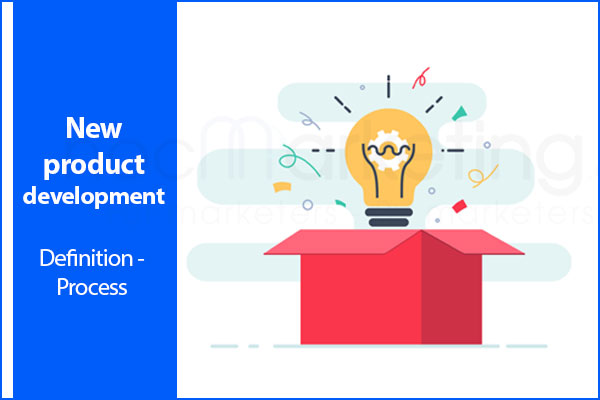
New product developement in Marketing

In the context of marketing, product development is a process that companies use to create new products. The most important part of this process is innovation- which leads to differentiation from competitors and sustainable competitive advantage.
In the context of marketing, product development is a process that companies use to create new products. The most important part of this process is innovation- which leads to differentiation from competitors and sustainable competitive advantage. This blog will explore how marketers can innovate their product and what they should do post launch for successful customer acquisition.
What is new product development?
New product development is a collection of work related to design, construction and development to create a product that can be commercialized, and has characteristics that are different from the products that the business currently has.
Why is new product development important to businesses?
Every business needs to innovate and develop new products to stay profitable. Innovation drives profits, leads to competitive advantage, improves customer satisfaction and productivity, enables better distribution channels for your product and allows the company to explore entirely new markets.
New product development process
The new product development process will include 7 steps: Concept creation, concept screening, concept development & testing, profit estimation, marketing mix strategy development, profit estimation, market testing, commercialization.
Step 1: Concept creation
The initial form of new products will start from ideas (concepts). In large enterprises, there is often a R&D department in charge of developing new product ideas. However, for small businesses, this work will be undertaken by the Marketing department or by other members of the business.
In addition, businesses can find ideas through surveying their own customers, or from suggestions and suggestions of distributors.
Some other businesses rely on competitors' products to generate ideas for new products.
Step 2: Concept screening
Enterprises after getting the ideas in step 1 will start the process of filtering them in step 2 to keep the most suitable ideas.
A suitable idea must meet the following criteria:
- Viable: The product idea must be accompanied by the right target audience that the business can reach, because otherwise the new product may not be sold to anyone. In addition, the process of creating and producing products from ideas must be feasible with resources, financial capabilities, and technology at the time of implementation.
- Commercializable: A company can bring a new product idea to mass production, with production costs within its means.
- Profitable: The expected price of the product must be greater than the cost of production. Of course, Products to market must be priced at a price that the target audience can afford to buy them.
- High competitiveness: The idea has a high breakthrough compared to competitors, bringing good competitiveness for businesses.
Usually, the criterion of high competitiveness will be inversely proportional to the criterion of feasibility. The more disruptive the idea, the lower the level of viability. On the contrary, the higher the safety, the more disruptive and competitive the product will be. Therefore, often there will be no perfect choice.
Step 3: Concept development & testing
The product ideas after passing the screen will be developed and tested by the enterprise. Aspects of testing at this stage include product operability, durability, safety, functionality, etc.
The people involved in the testing process can be the R&D department, the Marketing department, the company's leaders or employees. Information about new products at this stage is usually kept confidential. Leaking information can cause ideas to fall into the hands of opponents, leading to unnecessary losses and incidents.
The process of testing the model will help businesses get a relatively accurate figure in terms of time, manpower and cost of producing new products.
Step 4: Marketing mix strategy development
In this step, enterprises will proceed to develop marketing mix strategies for the new product model. If the 4Ps is the marketing mix model that the business is applying, the business has got the first element, which is Product. At this point, the business's job is to determine the remaining factors:
Price: What will be the price of the product when it hits the market? What are the possible pricing strategies for this new product?
Place: How does the business make the product accessible to the target audience? Which distribution channel will give the highest efficiency with the most reasonable cost?
Promotion: What Promotional Mix tools will businesses use to promote and promote new products? What is the marketing message related to the new product that the business wants to convey to the target customer?
Step 5: Profit estimation
Based on the marketing mix strategy outlined, businesses need to estimate the revenue and profit of the product. Businesses need to determine where the breakeven point of the business, and how long it will take for the business to reach that level of revenue. From there, draw up business plans to promote the business to achieve the set targets.
Step 6: Market testing
After having successfully tested product models, as well as having outlined the necessary marketing and business strategies, the enterprise will produce a limited number of new products and put them on the market for testing. experience. The goal at this stage is to get accurate information about:
- Customers' reactions, attitudes, feelings and evaluations after using new products.
- Competitors' reactions to new products.
- Efficiency and operating costs of distribution channels of new products (if any)
Depending on the value of the product, businesses can deploy the testing process in many different ways. There are many businesses that choose to produce and sell new products in limited quantities, others choose to bundle products when customers buy another product, or there are businesses that give gifts directly to old customers.
Through the information collected at this stage, businesses can have appropriate bases to adjust the characteristics of new products, as well as optimize marketing strategies to be more appropriate if necessary.
Step 7: Commercialization
After the new product has successfully passed the previous stages, the enterprise will be put into production in large quantities and start a business for a long time. Some other tasks may need to be done such as registration of intellectual property for a new mark, registration of circulation, registration of export...
Conclusion
In this article, we've outlined the steps of a new product development process. It's important to remember that all businesses are different and will have their own unique needs as they work through each stage in the new product development process.
It's important to remember that all businesses are different and will have their own unique needs as they work through each stage of the new product development process.






















